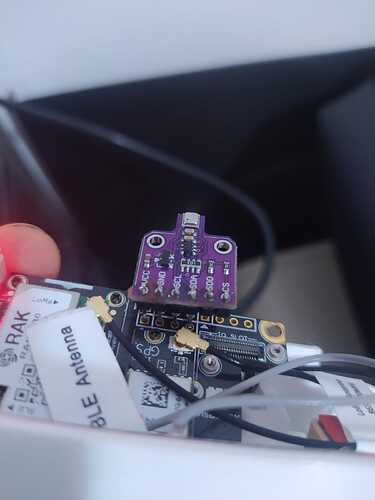hi everyone i have wisblock 4631 board and bme680 card. I connected to wisblock I2c and I can get the values. How can I add Lorawan, can you share the ready code?
BME680_Class BME680; ///< Create an instance of the BME680 class
///< Forward function declaration with default value for sea level
float altitude(const int32_t press, const float seaLevel = 1013.25);
float altitude(const int32_t press, const float seaLevel) {
/*!
@brief This converts a pressure measurement into a height in meters
@details The corrected sea-level pressure can be passed into the function if it is known,
otherwise the standard atmospheric pressure of 1013.25hPa is used (see
https://en.wikipedia.org/wiki/Atmospheric_pressure) for details.
@param[in] press Pressure reading from BME680
@param[in] seaLevel Sea-Level pressure in millibars
@return floating point altitude in meters.
*/
static float Altitude;
Altitude =
44330.0 * (1.0 - pow(((float)press / 100.0) / seaLevel, 0.1903)); // Convert into meters
return (Altitude);
} // of method altitude()
void setup() {
/*!
@brief Arduino method called once at startup to initialize the system
@details This is an Arduino IDE method which is called first upon boot or restart. It is only
called one time and then control goes to the main "loop()" method, from which
control never returns
@return void
*/
Serial.begin(SERIAL_SPEED); // Start serial port at Baud rate
#ifdef AVR_ATmega32U4 // If this is a 32U4 processor, then wait 3 seconds to init USB port
delay(3000);
#endif
Serial.print(F(“Starting I2CDemo example program for BME680\n”));
Serial.print(F("- Initializing BME680 sensor\n"));
while (!BME680.begin(I2C_STANDARD_MODE)) { // Start BME680 using I2C, use first device found
Serial.print(F("- Unable to find BME680. Trying again in 5 seconds.\n"));
delay(5000);
} // of loop until device is located
Serial.print(F("- Setting 16x oversampling for all sensors\n"));
BME680.setOversampling(TemperatureSensor, Oversample16); // Use enumerated type values
BME680.setOversampling(HumiditySensor, Oversample16); // Use enumerated type values
BME680.setOversampling(PressureSensor, Oversample16); // Use enumerated type values
Serial.print(F("- Setting IIR filter to a value of 4 samples\n"));
BME680.setIIRFilter(IIR4); // Use enumerated type values
Serial.print(F("- Setting gas measurement to 320\xC2\xB0\x43 for 150ms\n")); // “�C” symbols
BME680.setGas(320, 150); // 320�c for 150 milliseconds
} // of method setup()
void loop() {
/*!
@brief Arduino method for the main program loop
@details This is the main program for the Arduino IDE, it is an infinite loop and keeps on
repeating. The "sprintf()" function is to pretty-print the values, since floating
point is not supported on the Arduino, split the values into those before and those
after the decimal point.
@return void
*/
static int32_t temp, humidity, pressure, gas; // BME readings
static char buf[16]; // sprintf text buffer
static float alt; // Temporary variable
static uint16_t loopCounter = 0; // Display iterations
if (loopCounter % 25 == 0) { // Show header @25 loops
Serial.print(F("\nLoop Temp\xC2\xB0\x43 Humid% Press hPa Alt m Air m"));
Serial.print(F("\xE2\x84\xA6\n==== ====== ====== ========= ======= ======\n")); // "�C" symbol
} // if-then time to show headers
BME680.getSensorData(temp, humidity, pressure, gas); // Get readings
if (loopCounter++ != 0) { // Ignore first reading, might be incorrect
sprintf(buf, "%4d %3d.%02d", (loopCounter - 1) % 9999, // Clamp to 9999,
(int8_t)(temp / 100), (uint8_t)(temp % 100)); // Temp in decidegrees
Serial.print(buf);
sprintf(buf, "%3d.%03d", (int8_t)(humidity / 1000),
(uint16_t)(humidity % 1000)); // Humidity milli-pct
Serial.print(buf);
sprintf(buf, "%7d.%02d", (int16_t)(pressure / 100),
(uint8_t)(pressure % 100)); // Pressure Pascals
Serial.print(buf);
alt = altitude(pressure); // temp altitude
sprintf(buf, "%5d.%02d", (int16_t)(alt), ((uint8_t)(alt * 100) % 100)); // Altitude meters
Serial.print(buf);
sprintf(buf, "%4d.%02d\n", (int16_t)(gas / 100), (uint8_t)(gas % 100)); // Resistance milliohms
Serial.print(buf);
delay(10000); // Wait 10s
} // of ignore first reading
} // of method loop()
